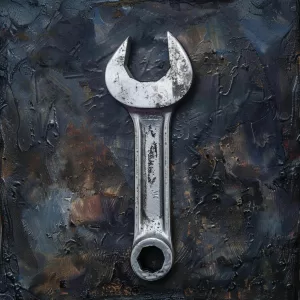
The Ultimate Guide to Choosing the Right Wrench for Every Job
April 22 2024 
Inquiry
Global electronic component supplier AMPHEO PTY LTD: Rich inventory for one-stop shopping. Inquire easily, and receive fast, customized solutions and quotes.
QUICK RFQ
ADD TO RFQ LIST
In this blog, we will equip you with the knowledge to not only select the perfect wrench but also use it effectively and safely.
What's a Wrench?

When Was the Wrench Invented?
The exact origin of the wrench remains unknown. Archaeological evidence indicates that wrench-like implements existed in ancient civilizations such as the Romans and Greeks. The adjustable wrench, a relatively modern invention, is credited to Swedish engineer Johan Petter Johansson in the late 1800s.How Many Types of Wrenches are there?
- Combination Wrench: This multifunctional tool has a closed-box end for a firm grip and an open end for quick fastener engagement. It's perfect for general jobs that require tightening and loosening.
- Box-End Wrench: As the name implies, this wrench features a fully enclosed box at the end that fits snuggly around the fastener. It delivers superior torque for high-pressure applications and confined places that require a full revolution.
- Open-End Wrench: This U-shaped wrench allows access to fasteners in tight spaces. While handy for initial engagement, it necessitates adjustment after each turn and may not be appropriate for high-torque applications.
- Adjustable Wrench: This wrench's jaws may be changed to fit a variety of fastener sizes. While helpful for working with different sizes on a single project, it may not provide the precise fit and tight grip of a dedicated wrench.
- Ratcheting Wrench: This novel wrench combines the functions of a wrench and a ratcheting mechanism. It enables continuous twisting in a single direction without the need to reposition the wrench, making it perfect for repetitive jobs and attaining unusual angles.
- Socket Wrench: This adaptable method uses replaceable sockets of various sizes that attach to a drive handle. It provides excellent grip and leverage, making it ideal for high-torque applications and working with fasteners in deep recesses.
- Torque Wrench: This specialized wrench ensures exact tightening by applying a predetermined torque amount. It is critical for applications where overtightening could harm components.
Video related to Wrenches
Why Wrench is Used?
Wrenches are used to deliver torque to turn and tighten or loosen threaded fasteners such as nuts, bolts, and screws. Here's a breakdown of their main functions:- Gripping: The wrench's head is designed to securely hold the flat sides or hexagonal (six-sided) shape of a nut or bolt head. This allows you to apply turning force without the wrench slipping.
- Turning and Adding Torque: By adding force to the wrench's handle, you rotate it, which then turns the nut or bolt owing to the grip. This rotating force is known as torque.
- Tightening or Loosening: Depending on the direction you crank the wrench, you can tighten or loosen the nut or bolt (push the threads together or pull the threads apart).
- Assemble furniture, machinery, and other items that require nuts and bolts to secure them.
- Repair appliances, cars, and plumbing devices that may require nut and bolt tightening or loosening.
- Maintain and adjust a variety of mechanical components that use threaded fasteners.
How Wrench Works?
Wrenches grab and turn fasteners such as nuts and bolts using two essential principles: mechanics and friction. Here's the breakdown:- The Right Fit: The wrench head is made to match the fastener's unique form. This maintains a proper fit and keeps the wrench from slipping while twisting. The most common head types are open-ended (U-shaped), box-ended (enclosed), and ratcheting sockets (interchangeable with different diameters).
- Gripping Power of Friction: The wrench head makes contact with several flat faces or sides of the fastening head. This causes friction between the wrench and the fastener, preventing them from spinning smoothly. The substance and texture of the wrench's head also help to maintain grip.
- Leverage and Torque: The wrench handle works as a lever. When you push or pull on the handle, you exert force away from the fastener (fulcrum point). This produces a turning force (torque), which is magnified by the lever concept. The length of the handle increases the mechanical advantage and makes it easier to spin a tight fastening.
- Rotational Control: By exerting force in a circular motion on the wrench handle, you rotate the wrench head, which then spins the fastener due to the secure hold. Depending on the direction of the turn, you can tighten or loosen the fastener.
How to Use a Wrench?
To use a wrench efficiently, one must have a fundamental awareness of the right technique:- Match the Wrench Size: Always use a wrench that is exactly the right size for the fastener. A sloppy fit can cause harm to both the wrench and the fastener.
- Secure Grasp: For a tight and secure grasp, ensure that the wrench is facing the correct direction on the fastener. Apply even pressure to avoid slipping and rounding off corners.
- Controlled Force: To tighten or loosen the fastener, use steady, controlled force. Avoid employing too much force, since this might break the wrench or damage the threads.
- Leverage Matters: For tough fasteners, use the entire length of the wrench handle to maximize leverage. Cheater bars (extensions) should not be used on adjustable wrenches because they can cause harm.
Are Wrenches and Spanners the Same?
In essence, wrenches and spanners are extremely similar tools that perform the same function: exerting torque to grip, turn, tighten, or loosen fasteners such as nuts and bolts. However, there are some regional variances in the usage of the terms wrench and spanner:- United States: This instrument is commonly referred to as a "wrench" in the United States, regardless of its design.
- United Kingdom: In the UK, they tend to distinguish between the two terms.
- Spanner: This is a wrench with a fixed head size that is designed to fit over the nut or bolt head in an open-ended U shape.
- Wrench: This phrase may refer to an adjustable wrench with an opening that can be adjusted to accommodate various fastener sizes.
Where to Buy a Wrench?
Wrenches are widely accessible in hardware stores, home improvement centers, online sellers, and car parts stores. Prices vary according to the type, size, and quality of the wrench.Conclusion
Understanding the many types of wrenches, their capabilities, and suitable usage procedures will enable you to select the best tool for any work. Remember, the key is to match the wrench to the precise operation and fastener size. When precision is critical, consider investing in a good torque wrench.Related Articles
- ·Stratix 10 VS Stratix V: Which FPGA is Right for Your Next Project?
- ·Intel Xeon Platinum 8454H vs AMD EPYC: Which Reigns Supreme?
- ·A Deep Dive into the AMD EPYC 4564P Processor
- ·MSP430F5438A vs MSP430F5529: A Detailed Analysis of Their Capabilities
- ·Comparing MSP430F6659 and MSP430F5419A: Which One is Right for Your Project?
- ·Exploring the Features of MSP430F5529 and MSP430F5638 Microcontrollers
- ·Demystifying 20 Microcontroller Projects for Beginners
- ·Unveiling the Ultimate Guide to Microcontroller Programming
- ·4680 Battery: Unveiling the Power Potential of the Next-Gen Cell
- ·Exploring the Case Studies on Arduino Applications
Populer Posts
XE161FU8F40VAAKXUMA1
Infineon Technologies
R7FS3A37A2A01CLK#BC0
Renesas Electronics America Inc
DSPIC33EP128MC506-I/MR
Microchip Technology
CY9AF116NAPMC-GE1
Infineon Technologies
CY8C4247LQQ-BL483T
Infineon Technologies
R5F113PLCKFB#35
Renesas Electronics America Inc
PIC16F1939-E/P
Microchip Technology
R5F56609BGFP#10
Renesas Electronics America Inc
PIC16C621A-04E/P
Microchip Technology
XC886CM8FFI5VACFXUMA1
Infineon Technologies
R5F51103AGFK#10
Renesas Electronics America Inc
EFM32TG222F8-D-QFP48R
Silicon Labs
